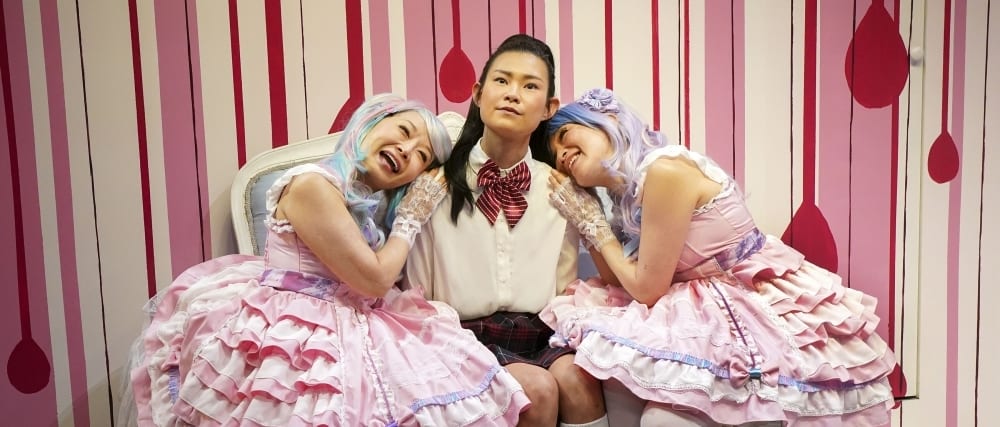Haruna Lee’s Suicide Forest, an experimental play that wrestles with questions of Japanese-American cultural and sexual identity and psychology in a way both highly abstract and deeply personal, originally ran at the Bushwick Starr in 2019 and has now returned for an engagement at A.R.T./New York Theatres.
An attempt at description won’t do justice to this dreamscape of a play—what the director Aya Ogawa calls a “nightmare play”—which unfolds on Jian Jung’s candy-striped set, reminiscent of a doll’s house if it were designed by David Lynch. Most of the play is in English, but the characters occasionally speak Japanese.
The audience is first greeted by the appearance of Mad Mad (Aoi Lee), “a god who shepherds human towards their death.” Mad Mad, in her red kimono, soon cedes the stage, but she haunts the play, appearing periodically in a painting/mirror/portal. The first act’s protagonist is a Salaryman, which, according to the script, “is the face of Japanese masculinity in the last century or so. Hostility and rage, subordination and complicity, dance chaotically inside of him.”
As portrayed by Eddy Toru Ohno, who seems to never fully stand upright, but is rather perpetually crouched and bent, the Salaryman is by turns timid and self-loathing, sad and forlorn, and aggressive and sexually violent. In his interaction with an unnamed friend (a very funny Keizo Kaji), they discuss a forest “at the base of the national mountain” (presumably Aokigahara, or the Sea of Trees), where people go “and never come back.” This is followed by a strange masochistic interlude with the Salaryman’s “office lady” (Yuki Kawahisa), which further blurs distinctions between fantasy and reality, and then a visit from his daughters, Miho (Ako) and Chiho (Dawn Akemi Saito), pink-clad and with blonde pig-tailed wigs and full of high-pitched laughter, dragging along a life-sized “doll” named Azusa (Haruna Lee), dressed in plaid skirt as a schoolgirl.
That there are moments of humor throughout, including a parody of a gameshow prank in which the Salaryman is being secretly observed as he dismissed from his job, somehow adds to how disturbing the play can be. The burlesque with Miho and Chiho soon turns into the Salaryman’s molestation of Azusa. Again quoting Ogawa, the play depicts a “world where girls are hypersexualized, commodified and infantilized.” When Azusa has come to life from doll to fully human, she eventually escapes through the portal, into the forest, where she encounters a clan of talking goats.
And here in the dark and otherworldly forest of Act 2 the play takes a startling, fourth-wall-breaking turn: the actors drop their characters and become “themselves,” the lights come up, and Azusa, as Lee, addresses the audience: “So … I want to take responsibility for this.” In what follows, Lee discusses their childhood in Seattle and the language barrier with their own mother, their cultural identity and what “percentage” Japanese they feel at different times. They then ask the other performers to “share your percentage today between Japanese and American.” Lee then introduces their mother, the performer playing Mad Mad.
Until this final sequence, the play’s heightened theatricality and strangeness is interesting and provocative though somewhat opaque. But the concluding scene’s exploration of Japanese-American identity and the relationship between mother and child is moving, complex, and gripping. Those who missed Suicide Forest in Bushwick will be grateful for another opportunity to see this haunting, and haunted, work.

